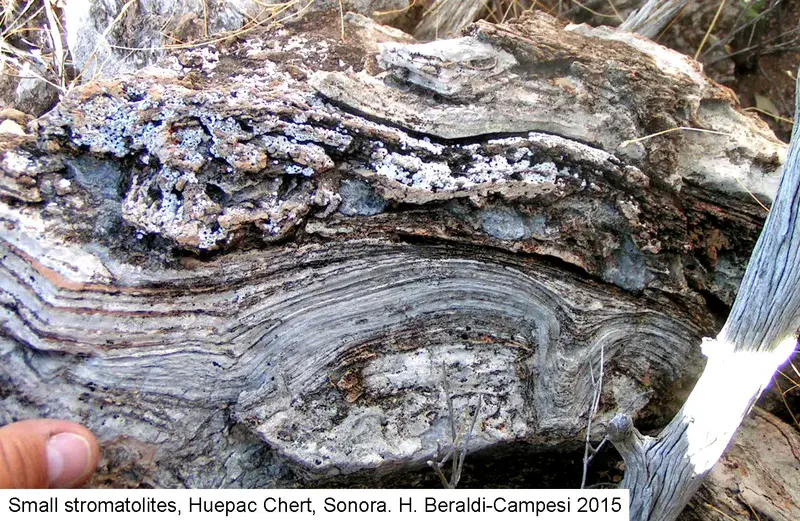
Huepac stromatolites
by Hugo Beraldi, UNAM, Mexico, Mexico
Microbialites exist in the rock record since 3700 Ma ago until our days. The presence of microbes in environments where mineral precipitation is prevalent, usually derives in the development of such chemical sedimentary structures. This can take place in marine, non-marine, and subterranean environments. The most common type of microbialites may be referred to as stromatolites.
The stromatolites shown here formed ~72 Ma ago in an intra-arc basin within the Tarahumara Formation, which was emplaced during the Laramide orogeny in Northwestern Mexico (Sonora). The locality has been named the Huepac Chert because of the presence of thin and thick chert horizons. The chert is black and it contains a great variety of fossils, including angiosperm and gymnosperm pollen grains, fungal hyphae and spores, green algae, cyanobacteria, diatoms, arthropod remains, fruits, palm roots, aquatic plants (e.g. Haloragaceae), and numerous achritarchs.
Preliminary studies of the Fe2O3/TiO2 and MnO/TiO2 ratios in the chert suggest that hydrothermal activity was frequent and that it promoted the deposition of the majority of the chert where important organisms are beautifully preserved. Fe-rich laminae, instraclasts, and evaporation processes may be inferred for the topmost sediments covering the stromatolites, suggesting that the water level fluctuated while these structures were forming.
There is still much work to do regarding the paleoenvironments where those Cretaceous stromatolites developed. These Upper Cretaceous successions are rare in Sonora, and biostratigraphic correlations that can be made only with one locality to the South (Cerro El Obispo), but no other localities with similar lithology and fossil content have been reported.
Featured on GeoLog, the official blog of the European Geosciences Union
Category
Location
Colours
Image properties
1500 × 976 px;
image/jpeg; 366.9 KB
Submitted on 25 February 2016
Licence
Creative Commons Attribution 3.0 Unported (CC BY 3.0)
Credit
Hugo Beraldi (distributed via imaggeo.egu.eu)
Share
Appreciate
Report
Hugo Beraldi 9 years, 2 months ago
These stromatolites formed ~72 Ma ago in an intra-arc basin within the Tarahumara Formation, which was emplaced during the Laramide orogeny in Northwestern Mexico (Sonora). The locality has been named the Huepac Chert because of the presence of thin and thick chert horizons. The chert is black and it contains a great variety of fossils, including angiosperm and gymnosperm pollen grains, fungal hyphae and spores, green algae, cyanobacteria, diatoms, arthropod remains, fruits, palm roots, aquatic plants (e.g. Haloragaceae), and numerous achritarchs.